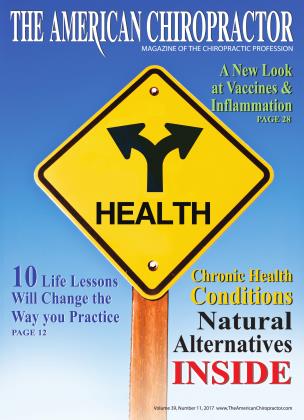NIH commits $7 million to Palmer Center for Chiropractic Research and Partners
NEWS
Study to assess Chiropractic Care for Veterans with Chronic Low-Back Pain
(Davenport, IOWA) — Scientists at the Palmer Center for Chiropractic Research (PCCR), along with partner organizations, received a $1.46 million award from the National Center for Complementary and Integrative Health and the Office of Research on Women’s Health at the National Institutes of Health (NIH). The award (UG3-AT009761) hinds a two-year research planning project to address the short-term pain and functional outcomes associated with different numbers of chiropractic visits, and the long-term effectiveness of chiropractic care delivered at Veterans Health Administration (VHA) clinics.
If the NIH determines initial project goals are met after
the two-year planning phase and pending available hinds, the project and funding will extend over an additional four years totaling approximately $7 million, making this the largest award ever granted by the NIH to a chiropractic institution.
“There is a pressing need to address the devastating impact of chronic low-back pain in U.S. Veterans,” said Principal Investigator Christine Goertz, D.C., Ph.D., Palmer College of Chiropractic’s vice chancellor for research and health policy.
“I’m extremely excited about the outstanding multidisciplinary team Palmer has brought together to look at dosing of chiropractic services, both during an episode of low-back pain and in preventing future episodes. We believe the results of this study have the potential to directly hnpact chiropractic health policy within the VHA and beyond.”
This award is part of a multi-disciplinary initiative sponsored by the NIH, Department of Defense and the Veterans Health Administration. It includes 11 pragmatic clinical studies, as well as a coordinating center that will support these projects. Partner organizations with the PCCR on this project are the Dartmouth Institute for Health Policy & Clinical Practice, Iowa City VA Health Care Systems, Minneapolis VA Health Care System, the University of Iowa, VA Connecticut Healthcare System, VA Greater Los Angeles Healthcare System, and Yale University.
The Palmer Center for Chiropractic Research, headquartered on Palmer College of Chiropractic’s main campus in Davenport, Iowa, is the most highly funded chiropractic research center in the U.S. Within the past 10 years, the PCCR has been awarded grants horn the NIH, the U.S. Health Resources and Services Administration and the Department of Defense, hi addition to private-foundation grants.
Performance Health Funds Expanded Study on Chiropractic’s Impact on Reduction in Opioid Prescriptions
Study will include over one million subjects.
Performance Health, the maker of Biofreeze® Professional, is pleased to announce its significant financial support of the Clinical Compass as part of its national Safer Pain Relief campaign. These funds are earmarked for a second study on the impact of chiropractic care on opioid and drug use for large patient populations. This second study, as was the first, is being carried out by principle investigator Dr. James Whedon at Southern California University of Health Sciences.
The first study, conducted in 2016 on over 12,000 subjects with lower back pain, revealed that patients seen by a chiropractor have a 55% less likelihood of filling an opioid prescription as compared to those not under chiropractic care. The study, Association between Utilization of Chiropractic Services and Use of Prescription Opioids Among Patients with Low Back Pain, also showed that average annual perperson charges for opioid prescription fills were 78% lower for recipients of chiropractic services as compared to nonrecipients. The final results of the study are currently under peer review for publication.
“This second study will have a massive impact on patients, providers of health services, payers and policy makers. We will not just be moving the needle with this study, we will be changing the game on how healthcare is delivered in our country, and be a major force in reducing opioid addiction,” stated Jay S. Greenstein, DC, Chairman, Clinical Compass. “We couldn’t do this study without Performance Health and their dedication to the chiropractic profession. Together, we can provide safer pain relief options for all the patients we serve.”
The second study will begin in late 2017 and will require at least 18 months to collect, analyze and report on the data.
“We are fully committed to advancing the impact of Dr. Whedon’s work knowing it will broaden the awareness and appreciation of chiropractic care, and ultimately save lives,” added Paul Timlco, Vice President, US Distribution, Performance Health. “In addition to our funding support, we are matching any doctor’s donation of $350 to the Clinical Compass. When a donation is made at that level, we will also provide the donor with a tower display of free Performance Health pain relief products including Biofreeze® Professional, TheraBand® Kinesiology Tape and Thera°Pearl® Reusable Hot/ Cold Wraps. At a $200 donation level, we will provide the doctor with a free counter display of products.”
“We are asking that everyone in our profession donate to the Clinical Compass. This imperative work will allow us to work more cooperatively with patients, other healthcare providers, payers and policy makers,” concluded Greenstein. Go to http://clinicalcompass.org/donate to make your contribution.
The goal of Performance Health's Safer Pain Relief campaign is simple: Help people understand the full range of muscle and joint pain relief options—and the associated risks and side effects—so they apply the safest, most effective solutions for their unique needs. We know the best way to get “safer pain relief’ is by combining professional care with professional products. Visit www.saferpainrelief.org to learn more!
 View Full Issue
View Full Issue









